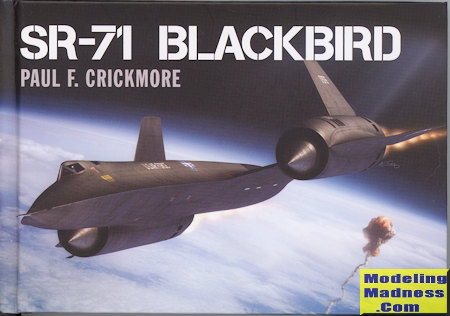 One of the most
written about aircraft of the last 30 years has to be the SR-71 Blackbird. It
has everything going for it. It is cool looking, it is stupid fast, its
development was shrouded in secrecy, it flew 'spy' missions and it was black.
The later was to allow the dissipation of heat that built up on the airframe
during its mach 3.2 missions. In fact, the airplane was flown flat out for quite
a bit of its life.
One of the most
written about aircraft of the last 30 years has to be the SR-71 Blackbird. It
has everything going for it. It is cool looking, it is stupid fast, its
development was shrouded in secrecy, it flew 'spy' missions and it was black.
The later was to allow the dissipation of heat that built up on the airframe
during its mach 3.2 missions. In fact, the airplane was flown flat out for quite
a bit of its life.
Originally developed as a single seat plane, the A-12,
for the CIA, this version was flown only for a relatively short time before it
was mothballed. This was because the two seat SR-71 was then in service with the
USAF and Congress was only willing to fund the operation of one type so the
single seaters went bye-bye and were never flown again. During the operational
life of the A-12, it was used almost exclusively for missions over Southeast
Asia and North Korea. The single seater was also used to develop the M-21/D-21
high speed drone system, a system that never really worked as planned. Though
the A-12 was originally developed for overflights of the Soviet Union, the loss
of the U-2 flown by Gary Powers in 1960 during an overflight meant that the A-12
was never used for its original purpose.
For the USAF, the SR-71 and YF-12A were developed. The
YF-12 was an attempt at making an interceptor and used the huge AIM-47 missile
system. This system was developed for the cancelled XF-108 Rapier. While it was
as relatively successful aircraft, there really was no need for it, especially
following the loss of two of the three prototypes, so it was cancelled.
This left the SR-71. While its camera system was
inferior to the one used in the A-12, it was able to utilize more sophisticated
systems. It is with the USAF that the Blackbird was to be most heavily used. If
there was a crisis somewhere, you could be sure that the 71 was going to be
taking photos.
Blackbirds were shot at many times as the Soviet SA-2
was able to reach the operating height of the A-12 and SR-71. Despite many
attempts, the aircraft was only hit one time and that was by a tiny piece of
shrapnel during an overflight of North Vietnam during the war. When the
Blackbird was brought out of arena of 'black ops', into 'white ops', it was no
longer able to be secretly funded. This meant that every year, the USAF had to
ask Congress for funding of the aircraft. As satellites became more and more
prevalent for planetary photography, it was felt by those who were not in the
know (which was most of Congress) that it was an anachronism. The USAF was also
tired of funding a system for which mission results had to be shared (yes, brass
can be extremely petty). Though still quite a capable system, the type was
retired.
NASA was also a user of the Blackbird for various
programs through the type's life. It was also able to operate three of them
after it as retired for a most interesting project, the Linear Spike. However,
despite a brief one year renewal of USAF ops, it was finally put to pasture.
Extant airframes were cut into sections, transported to museums and reassembled
for display.
The author covers the interesting development and
operations of the various aircraft lumped into the Blackbird family. The book
offers a lot of great photographs, pilot stories, and a section of what it took
to fly the plane. At the end of the book is a photo section showing all the
extant airframes and the museums at which they are now displayed. In all, it is
a great history of the type and one that I know you will find as fascinating a
read as did I.
April 2016
For more on the complete line of Osprey books,
visit
www.ospreypublishing.com.
If you would like your product reviewed fairly and fairly quickly, please
contact
me or see other details in the Note to
Contributors.
 One of the most
written about aircraft of the last 30 years has to be the SR-71 Blackbird. It
has everything going for it. It is cool looking, it is stupid fast, its
development was shrouded in secrecy, it flew 'spy' missions and it was black.
The later was to allow the dissipation of heat that built up on the airframe
during its mach 3.2 missions. In fact, the airplane was flown flat out for quite
a bit of its life.
One of the most
written about aircraft of the last 30 years has to be the SR-71 Blackbird. It
has everything going for it. It is cool looking, it is stupid fast, its
development was shrouded in secrecy, it flew 'spy' missions and it was black.
The later was to allow the dissipation of heat that built up on the airframe
during its mach 3.2 missions. In fact, the airplane was flown flat out for quite
a bit of its life.